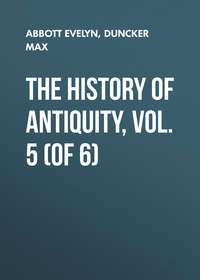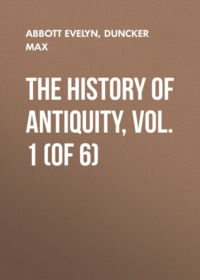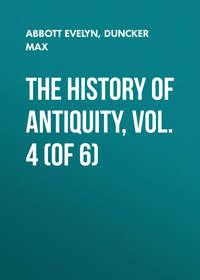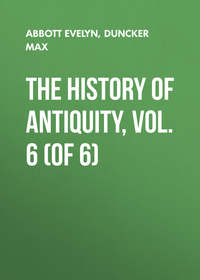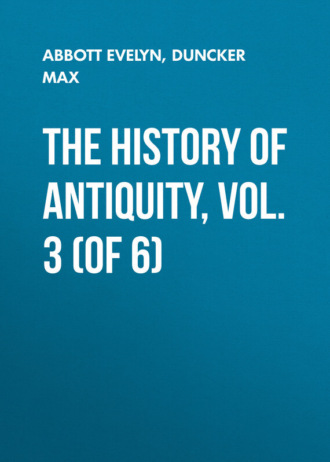 полная версия
полная версияThe History of Antiquity, Vol. 3 (of 6)
318
e. g. Nebbi Yunus in Ménant, loc. cit. p. 233.
319
Nebbi Yunus in Ménant, p. 231.
320
Alexander and Abydenus in Euseb. "Chron." I. p. 27, 35, ed. Schöne. For templum Atheniensium, it is obvious that we must read Anchialensium.
321
Private documents from the reign of Sennacherib on the sale of houses, vineyards, slaves, debts, are in existence from the years 699, 695, 694, 692, 687, 683, Oppert et Ménant, "Doc. juridiq." p. 169 ff.
322
Kings xix. 37. The statement of Josephus ("Antiq." 10, i. 5) rests only on this passage. In calling Adramelechus and Saraserus the elder sons of Sennacherib, and representing them as fleeing before the Assyrians to Armenia, he can scarcely have any other authority than this passage, although immediately before he quotes a passage of Berosus.
323
Bizana is a conjecture of Von Gutschmid for in Byzantinorum urbem.
324
G. Smith, "Assyr. Canon," p. 39.
325
Sayce, "Records of the Past," 7, 138.
326
Talbot, "Records of the Past," 3, 104-106.
327
Talbot, loc. cit. 3, 114.
328
Talbot, loc. cit.; Ménant, "Annal." p. 243.
329
Ménant, loc. cit. p. 248.
330
G. Smith, "Disc." p. 314.
331
Ménant, p. 248.
332
Ménant, p. 247.
333
Talbot, "Records of the Past," 3, 119; Ménant, p. 245.
334
Talbot, loc. cit. p. 118.
335
G. Smith, "Assyr. Canon," p. 137.
336
Talbot, "Records," 3, 116.
337
Talbot, loc. cit. p. 106, 116, 117.
338
So E. Schrader translates.
339
Vol. I. p. 547; Ménant, loc. cit. p. 242.
340
Talbot, "Records," 3, 106.
341
G. Smith, "Assyrian Canon," p. 137, 138.
342
E. Schrader, "K. A. T." s. 228; G. Smith, "Assyrian Canon," p. 139; Talbot, "Records," 3, 108; the name of Eteander of Paphus is also read on golden armlets, found at Kurion. Cf. G. Smith, "Assurbanipal," p. 31.
343
The year 697 is obtained for the accession of Manasses, by calculating the reigns of the kings of Judah from the date of the taking of Jerusalem by Nebuchadnezzar, i. e. from the year 586 B.C. As Hezekiah must have ascended the throne in 728B.C. (p. 17, n.), he reigned no doubt two years longer than the Books of Kings allow, which allot to him a reign of 29 years.
344
Chron. xxxiii. 11-13.
345
Ezra iv. 2, 9.
346
G. Smith, "Disc." p. 212.
347
G. Smith, "Assyr. Canon." p. 141.
348
In Eusebius, "Chron." I. p. 35, ed. Schöne.
349
Oppert, "Mémoires de l' Acad. des Inscript.," 1869, 1, 578. G. Smith, "Assyrian Canon," p. 169.
350
E. Schrader, "K. A. T." s. 212.
351
Psammetichus begins to reign in the year 664, according to the Egyptian reckoning, as will be shown below. The list of Manetho allots eight years to his father Necho. Necho, therefore, began to reign in 672 B.C., i. e. in the year in which Esarhaddon conquered Egypt. Nechepsus and Stephinates, whom Manetho places six and seven years before Necho, belong to the family of Psammetichus. Perhaps they were at the head of Isis, under Tirhaka; then Necho, the son of Nechepsus, would have made himself noticed by Esarhaddon by going over to him.
352
G. Smith, "Assurbanipal," p. 20 ff. Haigh, "Zur aeg. Sprache," 1871; s. 71 ff. The Muntimianche of Thebes may be the Month-em-ha of the inscription of the temple of Mut at Thebes, the pious foundations of which it enumerates; in a slab found in this temple he is called: "Hereditary lord, prince of Patores, prophet of Ammon." Brugsch, "Hist, of Egypt," II. 270.
353
Ménant, "Annal." p. 249.
354
Private documents on the sale of lands, slaves, on loans from the time of Esarhaddon, are in existence, belonging to the years 680, 677, 676, 674, 671. Oppert et Ménant, "Docum. jurid." Cf. G. Smith, "Disc." p. 415 ff.
355
G. Smith, "Assyr. Canon," p. 164.
356
G. Smith, "Disc." p. 320. E. Schrader, "K. A. T." s. 208. The astronomical canon makes Esarhaddon's reign in Babylon end with the year 668 B.C.
357
G. Smith, "Disc." p. 324.
358
G. Smith, "Disc." p. 322.
359
Assurbanipal, it is true, says that he has conquered Muzur and Cush (G. Smith, loc. cit. p. 324), which is certainly an exaggeration unless Upper Egypt is meant by Cush.
360
G. Smith, loc. cit. p. 328.
361
G. Smith, loc. cit. pp. 328, 329.
362
Nahum iii. 8-10.
363
The Apis-pillar from the twenty-first year of Psammetichus proves that the Egyptians put him immediately after Tirhaka. As they make the reign of Psammetichus commence with the year 664 B.C. the death of Tirhaka must fall in this year, and the war of Urdamane in the next.
364
Inhabitants of Karbit, in the land of Halahasta, were brought here; compare Cyl. B. in Ménant, "Ann." p. 291. If the king of the memorial stone of the ruins of the temple of Ammon at Napata, whose name is read with much uncertainty as Nuat-Mi (amun), or Amun-merinut, or Tonuat-amen, is not one and the same person with the Urdamane or Undamane (Unt-amen?) of Assurbanipal, it is very difficult to explain who he is. If the name of the person making dedications beside Tirhaka at Karnak is the same which the monument gives (Mariette, "Monum. divers." pl. 80, sqq.), this would be an important factor for the identification with Urdamane, which is also supported by the fact that Piker of Pasupti is prominent among the opponents of this Ethiopian: Pakruru of Pisaptu has been previously mentioned by Assurbanipal. The narrative of the memorial stone would then be the counterpart of the Assyrian account; the only striking thing in the narrative of the Ethiopian king is that the victory of Memphis is mentioned, but not the capture of the Assyrians. He ought also, it is true, to have mentioned the retreat forced upon him by the Assyrians. The narrative runs: In the year when he came to the throne Nuat-amon saw two serpents in a dream, and when he asked the interpretation of the dream, it was announced to him: "he possessed the south, he should conquer the north." He set out, and when he arrived at Thebes the prophet of the temple of Ammon-Ra met him with the astrologers, and the inhabitants who were at first hostile to him were filled with joy. But when Nuat-amon approached Memphis, the sons of the rebellion marched against him, in order to do battle: he inflicted on them a great defeat, and made himself master of the city of Memphis. From Memphis he marched out, in order to do battle with the chiefs of the land of the North, but they remained in their walls. When their cities were besieged, they appeared before Nuat-amon lying on their bellies, with their faces on the ground, and Piker the chief of Pasupti said: "Thou slayest whom thou wilt, and thou givest life to whom thou wilt, and all vow to be thy servants." The heart of Nuat-amon was full of joy when he heard these words. They turned back into their cities and sent all the good things of the North and the South to the lord of Upper and Lower Egypt. Maspero, "Essai sur la stèle du songe." Rev. Archéol. 1868, 17, 329 ff.
365
G. Smith, "Assurbanipal," p. 62, 63.
366
G. Smith, loc. cit. p. 74, 75.
367
G. Smith, loc. cit. p. 95 ff.
368
G. Smith, loc. cit. p. 115, 96, 97.
369
G. Smith, loc. cit. p. 151.
370
G. Smith, "Disc." p. 380.
371
G. Smith, "Assurb." p. 103. Ménant, "Annal." p. 282.
372
G. Smith, loc. cit. p. 107, 117.
373
Cylinder B., in G. Smith, loc. cit. p. 120 ff.
374
G. Smith, loc. cit. p. 140, 146. Ménant, "Annal." p. 286.
375
G. Smith, loc. cit. p. 133, 155, 142-145.
376
G. Smith, loc. cit. p. 171.
377
G. Smith, loc. cit. p. 154, 155, 169, 201. "Disc." p. 338.
378
Above, p. 163. It is certain that Psammetichus's reign ends in the year 610 B.C.; Boeckh, "Manetho," Zeitschr. "für Geschich.," s. 716 ff., Unger, "Manetho," s. 280. Herodotus and Manetho allot 54 years to the reign of Psammetichus, and an Apis-pillar tells us that a new Apis was installed in the month Athyr of the 54th year of the reign of Psammetichus. Necho therefore died before, or in the year 664 B.C. (610 + 54).
379
G. Smith, "Assurb." p. 66; "Disc." p. 332. In the computation of Herodotus, the accession of Gyges of Lydia takes place in 719 or 716, according as the fall of Sardis is put in 549 or 546 B.C.; his death takes place in 681 or 678 B.C. In the canon of Eusebius, on the same data, he is computed to have ascended the throne in 699 or 696, and to have reigned till 663 or 660. In the list of Lydian kings (Euseb. "Chron." I, p. 69, ed. Schöne), he ascended, on the same data, in 689 or 686, and reigned to 653 or 650 B.C. The latter dates must be accepted if Gyges sent help to Psammetichus. Samul-sum-ukin would not have found it necessary to invite the prince or princes of Miluhhi to rebellion, if Egypt had revolted from Assyria before his rebellion – Miluhhi must then be used on the cylinder in a wider sense for Egypt and Meroe – and Gyges could not send any help to Psammetichus, if he was not king himself. We are not in a position to fix accurately the date of the rebellion of Samul-sum-ukin, since the list of the Assyrian rulers breaks off with the year 665 B.C. The fact that it is the sixth war of Assurbanipal in which he marches against his brother – I enumerate the wars according to Cylinder A – only proves that the war cannot have taken place before 660 B.C. In the astronomical canon the reign of Saosduchinus ends with the year 648 B.C.; and we may therefore assume with certainty that the overthrow of Samul-sum-ukin took place in this year. How long before this Samul-sum-ukin took up arms, we do not know; he may very well have done so in the year 652 B.C. For the rebellion was not brought to a close till after a long siege of Babylon: or the rebellion may have commenced even earlier, so that Gyges could undoubtedly have sent help to Psammetichus in the last years of his reign. The cylinders, which narrate the history of the wars of Assurbanipal, date from the year of Samasdainani, who in Cylinder A is called viceroy of Accad, and on the others viceroy of Babel. We are not in a position to fix definitely the place of this year. A tablet of Erech bears the date of 20 Nisan of the twentieth year of Assurbanipal in Babel (Ménant, "Annal." p. 29 ff.). As Assurbanipal must have dated his rule in Babylon from the overthrow of Samul-sum-ukin, and Assurbanipal himself died in the year 626 B.C., Samul-sum-ukin's death must have taken place at least before 646 B.C. On the cylinders and on the reliefs in his palace at Nineveh, Assurbanipal merely calls himself king of Asshur. If in the documents relating to his buildings in Babylon as well as on the Babylonian brick already mentioned he calls himself king of Babel, it follows that these inscriptions belong to the period after the war with his brother. G. Smith, "Disc." p. 378, 380.
380
G. Smith, "Assurb." p. 199; Ménant, loc. cit. p. 288.
381
Ménant, loc. cit. p. 293; G. Smith, loc. cit. p. 165-168, 181.
382
G. Smith, "Disc." p. 349 ff. If Babylon fell in the sixth war, 648B.C., the destruction of Susa at the end of the eighth war cannot have taken place earlier than in the year 645 B.C.
383
G. Smith, "Disc." p. 371; "Assurb." p. 237, 241, 243, 304, 306; Ménant, loc. cit. p. 291.
384
Ezekiel xxxii. 24.
385
G. Smith, "Assurb." p. 299; "Assyr. Canon," p. 148.
386
G. Smith, "Disc." p. 370.
387
G. Smith, loc. cit. p. 370.
388
Joshua xix. 29.
389
Herod. 2, 157.
390
Diod. 1, 67.
391
Beginning of Cylinder C. in G. Smith, "Disc." p. 377.
392
Above, p. 108. G. Smith, "Assurb." p. 308.
393
End of Cylinder A. in G. Smith, "Disc." p. 372 ff.
394
Place, "Ninive." Pl. 57.
395
Ezek. xxi. 3-9.
396
Nahum iii. 17, 18.
397
Ezek. xxiii. 6, 12.
398
E. Schrader, "Z. D. M. G." 25, 449 ff.; G. Smith, "Assyrian Canon;" Vol. II. p. 328, and above, p. 171, note.
399
G. Smith, "Assurb." p. 252.
400
Isaiah v. 26-29.
401
Herod. 7, 63.
402
Isaiah xxxvii. 33; cf. 2 Kings xix. 32; above, p. 127.
403
Layard, "Nineveh," p. 378.
404
Vol. II. p. 4.
405
Nahum ii. 9; iii. 16.
406
G. Rawlinson, "Monarchies," 12, p. 254 ff.
407
Lyell, 'Elements of Geology,' ed. 3. p. 368.
408
Xenoph. "Anab." 3, 4, 7-9.
409
Layard, "Nineveh and its Remains," 2, 44.
410
The so-called Archive of Assurbanipal in chambers 40 and 41 on Layard's plan.
411
Lénormant, "Etudes Accadiennes," 1, 3, p. 67 ff.; E. Schrader, "Jen. Lit. Z." 4th April, 1874.
412
G. Smith, "Disc." p. 248.
413
G. Rawlinson, "Monarchies," 22, 16, 17; Layard, "Mon." Pl. 69 note, 45, 47, 48.
414
Ezekiel also supports this, xxiii. 14, 15.
415
Layard, loc. cit. p. 327, 328.
416
Layard, loc. cit. p. 304.
417
Above, p. 157, 162 ff.
418
2 Kings xxi. 3-16; xxiii. 4-14, 26; xxiv. 3. Jer. ii. 30; vii. 31; viii. 2, 19; xv. 4; xix. 4, 5.
419
2 Kings xxii. 3-20; Deut. xxxi. 9-13. The less weight will be given to the somewhat circumstantial account of the discovery given in Chronicles as compared with the Books of Kings because the details are only a development of what Hilkiah says to Zaphan.
420
Deut. iv. 32.
421
Deut. x. 14, 17.
422
Deut. x. 18.
423
Deut. v. 9.
424
Deut. iv. 15.
425
Deut. xxxi. 27.
426
Deut. xxviii. 12.
427
Deut. xxviii. 15; cf. iv. 27.
428
Deut. xxx. 1-10.
429
Deut. iv. 32-34.
430
Deut. vii. 7, 8.
431
Deut. x. 14, 15; iv. 37.
432
Deut. xxx. 11-14.
433
Deut. x. 16.
434
Deut. iv. 29.
435
Deut. xix. 9; x. 12.
436
Deut. xiii. 3; xi. 1; cf. vi. 4-6.
437
Deut. xii.; xvi. 16.
438
Deut. xv. 19, 20; iv. 22-29; xxvi. 12-15.
439
Deut. xii. 6, 11, 17; xiv. 27-29.
440
Deut. xviii. 6-8.
441
Deut. xx. 10-17.
442
Deut. vii. 1-4.
443
Deut. xvii. 2-7.
444
Deut. xiii. 1-5.
445
Deut. xiii. 6-11.
446
Deut. xiii. 12-17. Cf. Exod. xxii. 18, 20.
447
Deut. xvii. 14-20.
448
Deut. xxi. 5.
449
Deut. xvi. 8-12; xix. 17; xxv. 13.
450
Deut. xvii. 4, 6; xix. 15.
451
Deut. xix. 19.
452
Deut. xvi. 19; xxvii. 19.
453
Deut. xv.
454
Vol. II. p. 220.
455
Deut. xv. 6; xxiii. 20; xxviii. 12.
456
Deut. xv. 7-11.
457
Vol. II. p. 220.
458
Deut. xxiv. 6, 10-13, 17.
459
Deut. xii. 12; xvi. 11, 14; xv. 12-18.
460
Deut. xxiv. 15.
461
Deut. xxiv. 19-22.
462
Deut. xxvii. 19.
463
Deut. xxvii. 18. Cf. Levit. xix. 14.
464
Deut. xxii. 1-4.
465
Deut. xxi. 6.
466
Deut. xx. 19, 20.
467
Deut. xxv. 4.
468
Above, p. 31.
469
2 Kings xxiii. 4-25. 2 Chron. xxxiv.; xxxv. 1-9. Jesus, Son of Sirach, xlix. 1, 2.
470
"Iliad," 13, 5, 6. Strabo, p. 300, 302. Æsch. "Prom." 11. 1, 2, 416.
471
Herod. 1, 201; 4, 13, 27. On the confusion of the Araxes and Jaxartes in Herodotus, see vol. v.
472
Herod. 4, 21, 57, 123. Cf. Strabo, p. 496-498.
473
Herod. 4, 47-50.
474
Neumann, "Die Hellenen im Scythenlande," s. 202, 215.
475
Herod. 4, 47. Neumann, loc. cit. s. 80.
476
Herod. 4, 53.
477
Herod. 4, 18, 100, 106, 107, 125.
478
Tzetzes, "Chil." 7, 144, 163.
479
"Prom." 285, 802. Yet Æschylus appears to place the Arimaspi in the North-west, and not in the North-east.
480
Strabo, p. 311.
481
Herod. 4, 2, 61, 63.
482
Herod. 4, 114, 122.
483
Herod. 4, 75. Hippocr. "De Aere," p. 92, ed. Coray. Strabo, p. 307.
484
Neumann, loc. cit. s. 278 ff.
485
Herod. 4, 127. Herodotus represents Idanthyrsus as saying, "As my lords I acknowledge only Zeus (the sky-god), my forefather, and Hestia, the queen of the Scythians."
486
Herod. 4, 59.
487
Herod. 4, 5. The series of Scythian kings which can be collected from Herodotus is: Protothyas, about 650 B.C.; Madyras, about 630 B.C.; Saulius, about 550 B.C.; Idanthyrsus, about 500 B.C. Herod. I, 103; 4, 76. Beside this succession of kings we may place the pedigree of Anacharsis, who came to Hellas about 580 B.C., and must, therefore, have been born about 610 B.C. His father, Gnurus, was, therefore, born at the latest in 630 B.C.; his grandfather, Lycus, in 650 B.C.; and his great-grandfather, Spargapeithes, in 670 B.C.
488
Herod. 4, 78, 80.
489
Herod. 4, 69, 120.
490
Herod. 4, 69.
491
Herod. 4, 71, 78.
492
Herod. 4, 68.
493
Herod. 4, 71, 72.
494
Herod. 2, 167.
495
Cf. Curtius, 10, 1.
496
Ælian. "Nat. Anim." 2, 16; 9, 15.
497
Herod. 4, 3, 70.
498
Herod. 4, 64.
499
Herod. 4, 66.
500
Herod. 4, 64.
501
Herod. 4, 65.
502
Herod. 4, 73.
503
Herod. 6, 84; Hippocr., "De Morb.," 4, 13. "De Leg." p. 637.
504
Herod. 4, 110. Diod. 2, 46.
505
Herod. 4, 5.
506
Herod. 4, 27.
507
Herod. 4, 110.
508
Müllenhoff, "Monatsber. B.A." 1866, s. 555 ff, 576.
509
Zamyad Yascht, 56 ff.
510
Müllenhoff, loc. cit. s. 588.
511
Diod. 2, 43; Plin. "Hist. Nat." 6, 19.
512
Müllenhoff, loc. cit. s. 562.
513
Müllenhoff, loc. cit. s. 567.
514
Nicol. Dam. Frag. 9, ed. Müller. Athenæus, p. 529. Diod. 2, 24.
515
Athenæus, p. 528.
516
Diod. 2, 24-27.
517
Athenæus, p. 529.
518
Diod. 2, 28.
519
Diod. 2, 32-34.
520
Herod. 1, 95, 96.
521
Herod. 4, 1-4.
522
Herod. 1, 73, 74.
523
Herod. 1, 130.
524
Or, as in Ctesias the victory of Cyrus over Astyages is placed in 564 B.C. – even in the year 883 B.C. Cf. Vol. II., p. 26.



